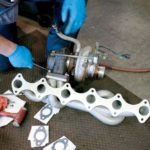What will give you the cheapest horsepower?
They’re easy to install. They don’t need any maintenance. And they’re cheap.
So if you’re thinking about tuning your vehicle, start with a carburetor spacer.
HOW DO CARBURETOR SPACERS WORK?

A carb spacer gives your manifold a longer neck. And this increases the volume of your intake’s plenum and runner, as well as the total distance between the bottom of the manifold and the bottom of the carburetor.
These increases create the space needed for the intake mixture to straighten out. And it becomes easier for your engine to take in more cool air, resulting in additional horsepower.
So how much additional horsepower will you get out of a carb spacer?
That depends on your current engine tunes.
Generally, installing a carb spacer will give you more top-end power at the expense of some bottom-end power.
But if you think about it, that’s not a bad trade-off. Especially if you have a high-rev engine.
You’ll end up with reduced low-end torque and an extended upper RPM range.
And what’s the best carb spacer for me?
There many options to choose from, with spacers varying in both their material make-up and construction type.
The best option for you will depend on exactly what you want to use the spacers for.
Yes, they will give you more horsepower.
But carb spacers have another important function. They also act as insulators which keep engine heat away from your carburetor to ensure cooler incoming air and fuel.
CARB SPACER MATERIALS

Carb spacers are generally made from wood, aluminum, phenolic resin, or polymer.
The material has a direct impact on the spacers’ insulation ability, as they all transfer heat at a different rate.
Or more scientifically put, the materials have varying thermal conductivity ratings, where a lower rating means better insulation.
Wood Carburetor Spacers
Wood has a thermal conductivity rating of 1.02, making it the best insulator in the group. Wood carb spacers are also cheaper and easier to shape.
But there are disadvantages.
Its pores are what make it such a good insulator. But they also make it extremely absorbent. This means that gasoline and any other chemical can easily soak in and warp the spacer. The results are vacuum leaks and a faster depreciation.
And because of this, you’ll have to inspect and replace your wood carb spacer often.
Phenolic Resin
This material is the second best insulator of the four, with a thermal conductivity rating of 2.01. It’s also more durable compared to wood. It’s not as porous, making it more resistant to chemicals.
So if your spacer’s insulation properties are important to you, but at the same time you don’t want to deal with any additional maintenance – a phenolic resin carb spacer might be perfect for you.
Polymer
Polymer, also known as plastic, has a thermal conductivity rating of 3.90.
But while the rating is bad news for insulation, it’s good news for the price – polymer spacers are cheaper than phenolic resin spacers.
And truthfully, some polymers insulate almost as well as phenolic resin.
Aluminum
Aluminum is not good at insulating.
At all.
Its thermal conductivity rating is 1,665.1.
So what are its advantages?
Aluminum is super durable. Aluminum will tune your intake charge. Aluminum carb spacers are the only ones allowed by the majority of racing sanctioning bodies.
 |
 |
 |
 |
CARB SPACER TYPE
Carb spacers are divided into 2 main types: open plenum and four-hole plenum.
Open Plenum Spacers
An open plenum carb spacer is ideal for maximizing horsepower. Their design will increase the intake manifold’s total area to build more mid-range, high-RPM power.
If you decide this is the type for you, purchase it in either wood or aluminum. Both materials are easy to shape, which you’ll probably want to do. Especially if you’re looking for a specific tuning effect over your engine’s RPM range.
Wood or aluminum carb spacers are also easily stacked to multiply their effect.
When you stack spacers, you are actually improving their insulation properties, and at the same time you’re getting more horsepower.
4-Hole Plenum Spacers
This type of spacer will increase the velocity of your vehicle’s air-to-fuel charge. This means you’ll build low to mid-range torque.
The 4-hole plenum spacer is most effective when it’s made from phenolic resin or a polymer. And the good news is that phenolic resin spacers can be stacked, the same way as wood or aluminum spacers.
So if insulation and durability are both important to you, this may be the spacer for you.
 |
 |
 |
 |
If you're still not sure which carb spacer is best for you, drop us a comment and we'll figure it out together!









My car is 1980 chevy camaro z28 with 350 engine
305 H.O (416)head with some port&polish
10:1 Compression
long tube headers (1 5/8 Primary Tube and 3 Collector)
2.5 exhaust kit with h pipe
Compcams xe262 (12-238-2)
Edelbrock intake 2701
holley 650dp
MSD 6425 6al
Th350 with summit G2699 torque converter (1700-2100 Stall)
3.42 Rear End((( I will go to change rear end to 3.73 in the future)))
Which CARBURETOR SPACERS is better for my car?
4 HOLE spacers OR OPEN spacers